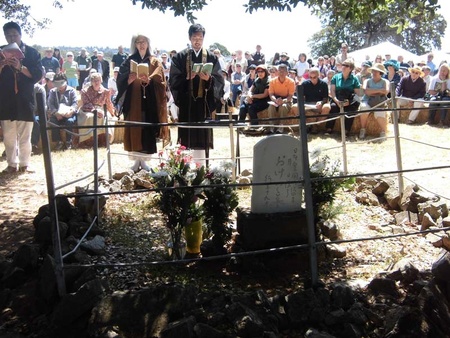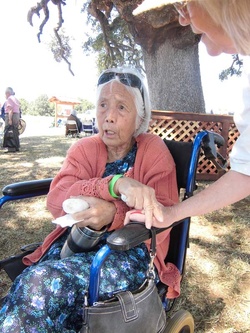Read Part 2 >>
It was a well-known grave for Japanese people.
Let's go back to the area in front of "Okei's Grave." The gravestone is surrounded by vegetation and is quietly built in the middle of a field. On this day, colorful flowers were placed there in the shade of the trees.
Naturally, the same inscriptions as those on the gravestone at Seaburiyama are inscribed on the front and back: "In Memory of OKEI Died 1871 Aged 19years," "Okei's Grave," "The sun set in the month of the 4th year of the Meiji era," and "Age at death was 19 years old." The date is not written.
Under the strong sunlight, a large crowd gathered at the grave from mid-morning, and Tyler Ryoei, a Sacramento resident and priest at the Tendai sect's Hawaii Betsuin temple, and others recited sutras and offered prayers at the grave, with the gathered crowd joining their hands in prayer.

Sutra reading took place in front of the grave with the gathered crowd behind them (Tyler Ryoei in the center)
One of them, George Oki (86), a second-generation Japanese American living in Sacramento, said he first visited the cemetery in 1962.
"I can imagine how difficult it must have been for them. They came to her grave out of respect for her." Okei's grave seems to have been well known among older Japanese people.
The Schnells brought tea, mulberry, and various other trees and seeds from Japan and started a farm. According to local newspaper articles from that time, the crops grew well in the first year, but then a dam was built for gold mining, cutting off the water supply, causing water shortages and the climate was bad.
Schnell apparently went to Japan with his family to raise funds, but never returned. There are accounts that he was killed, and that he later appeared in Geneva, but this is not certain.
The fate of the Japanese who were left behind varies, with some returning to Japan and others returning to the United States. There are two people whose whereabouts are clear who stayed behind: Sakurai Matsunosuke, who is said to have built Okei's grave, worked for the Beerkamp family his whole life. Another person known is Masumi Kuninosuke, who married a woman of black and Indian descent and has descendants today.
According to the Bierkamp family, Okei was a "nice girl" who was loved and learned how to cook and sew. We know a little about Sakurai and Masami, but unfortunately there is nothing left from them about how they came to be led by Schnell or the actual situation of the colony.
Furthermore, it is not clear what relationship this settlement plan had with the survival of the Aizu domain.
Finally, we'll have a farewell drink...
The remaining "legends" are mainly from the Bierkamp family. Kiyoko Hinesworth Fukumoto (86), who once had a connection with the family, was at the festival that day.
Originally from Kanagawa Prefecture, she married an American and lived here, and became acquainted with the elderly Henry Beerkamp family when her husband bought a cow from them. When he was a child, Okei and the Japanese colony were close by, so he remembered them well.
As she talked about him, Kiyoko told me about the last moments of the Japanese who were left behind. The Japanese had been living together until the very end in a farmhouse that has been preserved as a historical site, but it was about time for them to leave the farmhouse and disperse.
"Apparently there was one bottle left, and everyone decided to drink a little at a time before going their separate ways. But then Henry, as a child, got up to some mischief and spilled it, filling it with sand or something, making it undrinkable. That's what he told me."
Without even a farewell toast, they left the colony. Perhaps there are descendants somewhere in America.
The historical facts about Okei and the Wakamatsu Colony have been studied in Japan and the United States, and have been turned into novels and plays. There is a story that Okei often came to the hill where her grave is located and shed tears as she looked out over her hometown, but the truth of this story is unknown.
When Japan opened the door to modern times, Aizu was forced into a horrific war and its homeland was devastated. Behind the scenes, there were compatriots who went to America and struggled. Okei was a symbol of that.
Also, if we look at the present day, the damage in Aizu is minimal, but looking at Fukushima Prefecture as a whole, many of the victims of the nuclear accident are still forced to live in evacuation centers such as temporary housing, and are also taking refuge in temporary housing in Aizu.
A temporary junior high school has been built next to the school of Satsuki Koike, a first-year student in the Department of Industrial Information at the Aizu University Junior College who came to the festival from Aizuwakamatsu, for the junior high school students who were evacuated from Okuma Town.
"Some of my friends were affected by the disaster and had to evacuate, and when I see young people who have been forced to leave their hometowns because of the disaster, I see them as Okei who went to America," she says, thinking of Okei, who passed away at the same age as her.
People desperately resist, escape, or get caught up in the various situations of the times. The history of Aizu is one example, and Japanese Americans suffered the injustice of being forced to live in internment camps during the war.
There is no way to know what Okei was thinking when she came to America and when she died. However, this has encouraged many people to use their imaginations to think about her short but unique life.
(Titles omitted)
*This article is reprinted from JBPress (Japan Business Press) (published on June 17, 2013).
© 2013 Ryusuke Kawai, JB Press











